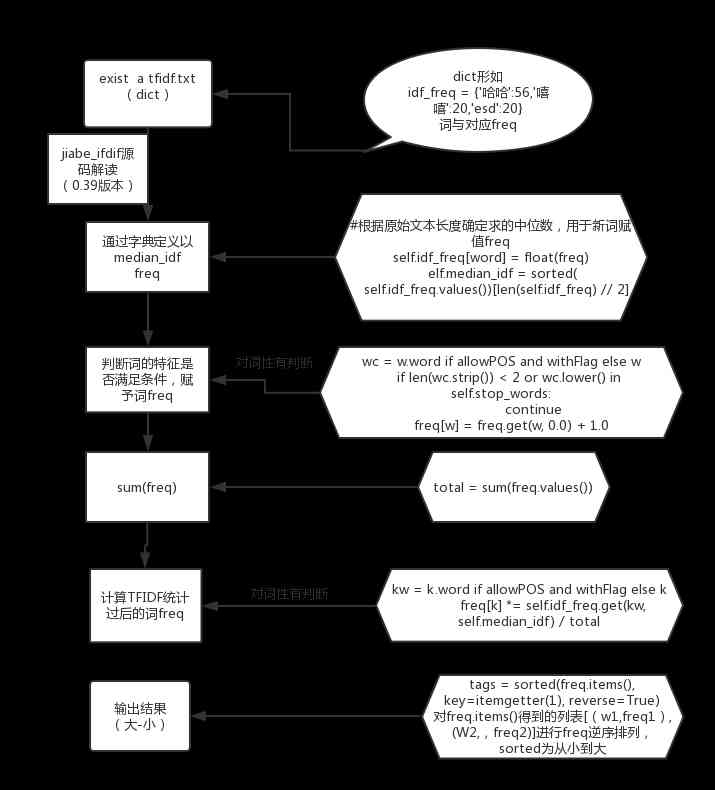当前位置:网站首页>python jieba分词(结巴分词)、提取词,加载词,修改词频,定义词库
python jieba分词(结巴分词)、提取词,加载词,修改词频,定义词库
2020-11-06 01:22:00 【IT界的小小小学生】
转载请注明出处
欢迎加入Python快速进阶QQ群:867300100
“结巴”中文分词:做最好的 Python 中文分词组件,分词模块jieba,它是python比较好用的分词模块, 支持中文简体,繁体分词,还支持自定义词库。
jieba的分词,提取关键词,自定义词语。
结巴分词的原理
这里写链接内容
#一、 基于结巴分词进行分词与关键词提取
##1、jieba.cut分词三种模式
- jieba.cut 方法接受三个输入参数: 需要分词的字符串;cut_all 参数用来控制是否采用全模式;HMM 参数用来控制是否使用
HMM 模型
jieba.cut_for_search 方法接受两个参数:需要分词的字符串;是否使用 HMM 模型。该方法适合用于搜索引擎构建倒排索引的分词,粒度比较细
待分词的字符串可以是 unicode 或 UTF-8 字符串、GBK 字符串。注意:不建议直接输入 GBK 字符串,可能无法预料地错误解码成 UTF-8
jieba.cut 以及 jieba.cut_for_search 返回的结构都是一个可迭代的 generator,可以使用 for 循环来获得分词后得到的每一个词语(unicode),或者用
jieba.lcut 以及 jieba.lcut_for_search 直接返回 list
jieba.Tokenizer(dictionary=DEFAULT_DICT) 新建自定义分词器,可用于同时使用不同词典。jieba.dt 为默认分词器,所有全局分词相关函数都是该分词器的映射。
#coding=utf-8
import jieba,math
import jieba.analyse
'''
jieba.cut主要有三种模式
#随便对一个动物园的评论进行分析
str_text="真是好久好久没来哈皮娜拉野生动物园了,记忆里还是小时候三四年级学校组织春游去的银河系"
#全模式cut_all=True
str_quan1=jieba.cut(str_text,cut_all=True)
print('全模式分词:{ %d}' % len(list(str_quan1)))
str_quan2=jieba.cut(str_text,cut_all=True)
print("/".join(str_quan2))
# print(str(str_1)) #为一个generator 用for循环可以得到分词的结果
# str_1_len=len(list(str_1)) #为什么?这里执行后后面.join 就不执行,求告知
#精准模式cut_all=False,默认即是
str_jing1=jieba.cut(str_text,cut_all=False)
print('精准模式分词:{ %d}' % len(list(str_jing1)))
str_jing2=jieba.cut(str_text,cut_all=False)
print("/".join(str_jing2))
#搜索引擎模式 cut_for_search
str_soso1=jieba.cut_for_search(str_text)
print('搜索引擎分词:{ %d}' % len(list(str_soso1)))
str_soso2=jieba.cut_for_search(str_text)
print("/".join(str_soso))
结果
全模式分词:{ 32}
Prefix dict has been built succesfully.
真是/TMD/好久/好久好久/好久/好久没/没来/哈/皮/娜拉/野生/野生动物/生动/动物/动物园/了///记忆/记忆里/还是/小时/小时候/时候/学校/组织/春游/游去/的/银河/银河系/河系
精准模式分词:{ 19}
真是/TMD/好久好久/没来/哈皮/娜拉/野生/动物园/了/,/记忆里/还是/小时候/学校/组织/春游/去/的/银河系
搜索引擎分词:{ 27}
真是/TMD/好久/好久/好久好久/没来/哈皮/娜拉/野生/动物/动物园/了/,/记忆/记忆里/还是/小时/时候/小时候/学校/组织/春游/去/的/银河/河系/银河系、
##2、关键词提取、关键词提取**
import jieba.analyse
’analyse.extract.tags‘
'''
keywords1=jieba.analyse.extract_tags(str_text)
print('关键词提取'+"/".join(keywords1))
keywords_top=jieba.analyse.extract_tags(str_text,topK=3)
print('关键词topk'+"/".join(keywords_to#有时不确定提取多少关键词,可利用总词的百分比
print('总词数{}'.format(len(list(jieba.cut(str_text)))))
total=len(list(jieba.cut(str_text)))
get_cnt=math.ceil(total*0.1) #向上取整
print('从%d 中取出%d 个词'% (total,get_cnt))
keywords_top1=jieba.analyse.extract_tags(str_text,topK=get_cnt)
print('关键词topk'+"/".join(keywords_top1))''
结果:
关键词提取TMD/哈皮/春游/好久好久/记忆里/娜拉/银河系/没来/动物园/小时候/野生/学校/真是/组织/还是
关键词topkTMD/哈皮/春游
总词数19
从19 中取出2 个词topkTMD/哈皮、
##3、加自定义词与加载自定义词库**
添加自定义词
================# 处理时,jieba.add_word
# add_word(word,freq=None,tag=None) 和del_word可在程序中动态修改词典
# suggest_freq(segment,tune=Ture)可调节单词词频,时期能或不能显示
# 注:自动计算的词频在使用HMM新词发现功能时可能无效
# '''
# str_jing2=jieba.cut(str_text,cut_all=False)
# print('add_word前:'+"/".join(str_jing2))
# #添加自定义词
# jieba.add_word('哈皮娜拉')
# str_jing3=jieba.cut(str_text,cut_all=False)
# print('add_word后:'+"/".join(str_jing3))
# #修正词频
# jieba.suggest_freq('野生动物园',tune=True)
# str_jing4=jieba.cut(str_text,cut_all=False)
# print('suggest_freq后:'+"/".join(str_jing4))
#
结果:
**add_word前:**真是/TMD/好久好久/没来/哈皮/娜拉/野生/动物园/了/,/记忆里/还是/小时候/学校/组织/春游/去/的/银河系
add_word后:真是/TMD/好久好久/没/来/哈皮娜拉/野生/动物园/了/,/记忆里/还是/小时候/学校/组织/春游/去/的/银河系
suggest_freq后:真是/TMD/好久好久/没/来/哈皮娜拉/野生动物园/了/,/记忆里/还是/小时候/学校/组织/春游/去/的/银河系
加载自定义词库
jieba.load_userdict(filename)#filename为文件路径
词典格式和dict.txt一样,一词一行,每行分三个部分(用空格隔开),词语 词频(可省) 词性(可省)
顺序不可颠倒,若filename为路径或二进制方式打开,则需为UTF-8
'''
#定义:三四年级 在文件内
jieba.load_userdict('C:\\Users\\lenovo\\Desktop\\自定义词库.txt')
str_load=jieba.cut(str_text,cut_all=False)
print('load_userdict后:'+"/".join(str_load))
'''
注jieba.load_userdict加载自定义词库和jieba初始化词库一同使用,
但是,默认的初始词库放在安装目录ixia,如果确定长期加载词库,就替换他
使用词库的切换功能set_dictionary()
可将jieba默认词库copy到自己的目录下,在添加,或者找到更全的词库
'''
#一般在python都为site-packages\jieba\dict.txt
#模拟演示
jieba.set_dictionary('filename')
#之后进行分词,如果我们切换了词库,此时程序就会初始化
我们制定的词库,而不加载默认路径词库
使用:
-安装或者将jieba目录放在当前目录或者site-packages目录
算法:
-基于前缀词典实现高效的词图扫描,生成句子中汉字所有可能成词情况所构成的有向无环图(DAG)
-采用动态规划查找最大概率路径,找出基于词频的最大切分组合
-对于未登录词,采用了基于汉字成词能力的HMM模型,使用了Viterbi算法
添加自定义词典
-开发者可以指定自己自定义的词典,以便包含jieba词库里没有的词。虽然jieba有新词识别能力,但是自行添加新词可以保证更高的正确率
-用法:jieba.load_userdict(file_name)#file_name为文件类对象 或自定义词典的路径
-词典格式:一个词一行:词语,词频(可省略),词性(可省略),用空格隔开,顺序不可颠倒。UTF-8编码。
关键词提取:
##4、基于TF-IDF算法的关键词抽取
import jieba.analyse
jieba.analyse.extract_tags(sentence, topK=20, withWeight=False, allowPOS=())
–sentence 为待提取的文本
–topK 为返回几个 TF/IDF 权重最大的关键词,默认值为 20
–withWeight 为是否一并返回关键词权重值,默认值为 False
–allowPOS 仅包括指定词性的词,默认值为空,即不筛选
jieba.analyse.TFIDF(idf_path=None) 新建 TFIDF 实例,idf_path 为 IDF 频率文件
关键词提取所使用逆向文件频率(IDF)文本语料库可以切换成自定义语料库的路径
用法:jieba.analyse.set_idf_path(file_name) # file_name为自定义语料库的路径
关键词提取所使用停止词(Stop Words)文本语料库可以切换成自定义语料库的路径
用法: jieba.analyse.set_stop_words(file_name) # file_name为自定义语料库的路径
##5、基于TextRank算法的关键词提取
jieba.analyse.textrank(sentence, topK=20, withWeight=False, allowPOS=(‘ns’, ‘n’, ‘vn’, ‘v’)) 直接使用,接口相同,注意默认过滤词性。
jieba.analyse.TextRank() 新建自定义 TextRank 实例
–基本思想:
1,将待抽取关键词的文本进行分词
2,以固定窗口大小(默认为5,通过span属性调整),词之间的共现关系,构建图
3,计算图中节点的PageRank,注意是无向带权图

对于itemgetter()用法参照连接
#二、 常用NLP扩充知识点(python2.7)
##Part 1. 词频统计、降序排序
article = open("C:\\Users\\Luo Chen\\Desktop\\demo_long.txt", "r").read()
words = jieba.cut(article, cut_all = False)
word_freq = {}
for word in words:
if word in word_freq:
word_freq[word] += 1
else:
word_freq[word] = 1
freq_word = []
for word, freq in word_freq.items():
freq_word.append((word, freq))
freq_word.sort(key = lambda x: x[1], reverse = True)
max_number = int(raw_input(u"需要前多少位高频词? "))
for word, freq in freq_word[: max_number]:
print word, freq
##Part 2. 人工去停用词
标点符号、虚词、连词不在统计范围内。
stopwords = []
for word in open("C:\\Users\\Luo Chen\\Desktop\\stop_words.txt", "r"):
stopwords.append(word.strip())
article = open("C:\\Users\\Luo Chen\\Desktop\\demo_long.txt", "r").read()
words = jieba.cut(article, cut_all = False)
stayed_line = ""
for word in words:
if word.encode("utf-8") not in stopwords:
stayed_line += word + " "
print stayed_line
##Part 3. 合并同义词
将同义词列举出来,按下Tab键分隔,把第一个词作为需要显示的词语,后面的词语作为要替代的同义词,一系列同义词放在一行。
这里,“北京”、“首都”、“京城”、“北平城”、“故都”为同义词。
combine_dict = {}
for line in open("C:\\Users\\Luo Chen\\Desktop\\tongyici.txt", "r"):
seperate_word = line.strip().split("\t")
num = len(seperate_word)
for i in range(1, num):
combine_dict[seperate_word[i]] = seperate_word[0]
jieba.suggest_freq("北平城", tune = True)
seg_list = jieba.cut("北京是中国的首都,京城的景色非常优美,就像当年的北平城,我爱这故都的一草一木。", cut_all = False)
f = ",".join(seg_list)
result = open("C:\\Users\\Luo Chen\\Desktop\\output.txt", "w")
result.write(f.encode("utf-8"))
result.close()
for line in open("C:\\Users\\Luo Chen\\Desktop\\output.txt", "r"):
line_1 = line.split(",")
final_sentence = ""
for word in line_1:
if word in combine_dict:
word = combine_dict[word]
final_sentence += word
else:
final_sentence += word
print final_sentence
##Part 4. 词语提及率
主要步骤:分词——过滤停用词(略)——替代同义词——计算词语在文本中出现的概率。
origin = open("C:\\Users\\Luo Chen\\Desktop\\tijilv.txt", "r").read()
jieba.suggest_freq("晨妈妈", tune = True)
jieba.suggest_freq("大黑牛", tune = True)
jieba.suggest_freq("能力者", tune = True)
seg_list = jieba.cut(origin, cut_all = False)
f = ",".join(seg_list)
output_1 = open("C:\\Users\\Luo Chen\\Desktop\\output_1.txt", "w")
output_1.write(f.encode("utf-8"))
output_1.close()
combine_dict = {}
for w in open("C:\\Users\\Luo Chen\\Desktop\\tongyici.txt", "r"):
w_1 = w.strip().split("\t")
num = len(w_1)
for i in range(0, num):
combine_dict[w_1[i]] = w_1[0]
seg_list_2 = ""
for i in open("C:\\Users\\Luo Chen\\Desktop\\output_1.txt", "r"):
i_1 = i.split(",")
for word in i_1:
if word in combine_dict:
word = combine_dict[word]
seg_list_2 += word
else:
seg_list_2 += word
print seg_list_2
freq_word = {}
seg_list_3 = jieba.cut(seg_list_2, cut_all = False)
for word in seg_list_3:
if word in freq_word:
freq_word[word] += 1
else:
freq_word[word] = 1
freq_word_1 = []
for word, freq in freq_word.items():
freq_word_1.append((word, freq))
freq_word_1.sort(key = lambda x: x[1], reverse = True)
for word, freq in freq_word_1:
print word, freq
total_freq = 0
for i in freq_word_1:
total_freq += i[1]
for word, freq in freq_word.items():
freq = float(freq) / float(total_freq)
print word, freq
##Part 5. 按词性提取
import jieba.posseg as pseg
word = pseg.cut("李晨好帅,又能力超强,是“大黑牛”,也是一个能力者,还是队里贴心的晨妈妈。")
for w in word:
if w.flag in ["n", "v", "x"]:
print w.word, w.flag
以下内容来源于网络收集
3. 关键词提取
基于 TF-IDF 算法的关键词抽取
import jieba.analyse
jieba.analyse.extract_tags(sentence, topK=20, withWeight=False, allowPOS=())
sentence 为待提取的文本
topK 为返回几个 TF/IDF 权重最大的关键词,默认值为 20
withWeight 为是否一并返回关键词权重值,默认值为 False
allowPOS 仅包括指定词性的词,默认值为空,即不筛选
分词词性可参见博客:[词性参考](http://blog.csdn.net/HHTNAN/article/details/77650128)
jieba.analyse.TFIDF(idf_path=None) 新建 TFIDF 实例,idf_path 为 IDF 频率文件
代码示例 (关键词提取)
https://github.com/fxsjy/jieba/blob/master/test/extract_tags.py
关键词提取所使用逆向文件频率(IDF)文本语料库可以切换成自定义语料库的路径
用法: jieba.analyse.set_idf_path(file_name) # file_name为自定义语料库的路径
自定义语料库示例:https://github.com/fxsjy/jieba/blob/master/extra_dict/idf.txt.big
用法示例:https://github.com/fxsjy/jieba/blob/master/test/extract_tags_idfpath.py
关键词提取所使用停止词(Stop Words)文本语料库可以切换成自定义语料库的路径
用法: jieba.analyse.set_stop_words(file_name) # file_name为自定义语料库的路径
自定义语料库示例:https://github.com/fxsjy/jieba/blob/master/extra_dict/stop_words.txt
用法示例:https://github.com/fxsjy/jieba/blob/master/test/extract_tags_stop_words.py
关键词一并返回关键词权重值示例
用法示例:https://github.com/fxsjy/jieba/blob/master/test/extract_tags_with_weight.py
基于 TextRank 算法的关键词抽取
jieba.analyse.textrank(sentence, topK=20, withWeight=False, allowPOS=('ns', 'n', 'vn', 'v')) 直接使用,接口相同,注意默认过滤词性。
jieba.analyse.TextRank() 新建自定义 TextRank 实例
算法论文: TextRank: Bringing Order into Texts
基本思想:
将待抽取关键词的文本进行分词
以固定窗口大小(默认为5,通过span属性调整),词之间的共现关系,构建图
计算图中节点的PageRank,注意是无向带权图
使用示例:
见 test/demo.py
4. 词性标注
jieba.posseg.POSTokenizer(tokenizer=None) 新建自定义分词器,tokenizer 参数可指定内部使用的 jieba.Tokenizer 分词器。jieba.posseg.dt 为默认词性标注分词器。
标注句子分词后每个词的词性,采用和 ictclas 兼容的标记法。
用法示例
import jieba.posseg as pseg
words = pseg.cut(“我爱北京天安门”)
for word, flag in words:
… print(’%s %s’ % (word, flag))
…
我 r
爱 v
北京 ns
天安门 ns
-
并行分词
原理:将目标文本按行分隔后,把各行文本分配到多个 Python 进程并行分词,然后归并结果,从而获得分词速度的可观提升
基于 python 自带的 multiprocessing 模块,目前暂不支持 Windows用法:
jieba.enable_parallel(4) # 开启并行分词模式,参数为并行进程数
jieba.disable_parallel() # 关闭并行分词模式例子:https://github.com/fxsjy/jieba/blob/master/test/parallel/test_file.py
实验结果:在 4 核 3.4GHz Linux 机器上,对金庸全集进行精确分词,获得了 1MB/s 的速度,是单进程版的 3.3 倍。
注意:并行分词仅支持默认分词器 jieba.dt 和 jieba.posseg.dt。
-
Tokenize:返回词语在原文的起止位置
注意,输入参数只接受 unicode
默认模式
result = jieba.tokenize(u’永和服装饰品有限公司’)
for tk in result:
print(“word %s\t\t start: %d \t\t end:%d” % (tk[0],tk[1],tk[2]))
word 永和 start: 0 end:2
word 服装 start: 2 end:4
word 饰品 start: 4 end:6
word 有限公司 start: 6 end:10
搜索模式
result = jieba.tokenize(u’永和服装饰品有限公司’, mode=‘search’)
for tk in result:
print(“word %s\t\t start: %d \t\t end:%d” % (tk[0],tk[1],tk[2]))
word 永和 start: 0 end:2
word 服装 start: 2 end:4
word 饰品 start: 4 end:6
word 有限 start: 6 end:8
word 公司 start: 8 end:10
word 有限公司 start: 6 end:10
-
ChineseAnalyzer for Whoosh 搜索引擎
引用: from jieba.analyse import ChineseAnalyzer
用法示例:https://github.com/fxsjy/jieba/blob/master/test/test_whoosh.py
-
命令行分词
使用示例:python -m jieba news.txt > cut_result.txt
命令行选项(翻译):
使用: python -m jieba [options] filename
结巴命令行界面。
固定参数:
filename 输入文件
可选参数:
-h, --help 显示此帮助信息并退出
-d [DELIM], --delimiter [DELIM]
使用 DELIM 分隔词语,而不是用默认的’ / '。
若不指定 DELIM,则使用一个空格分隔。
-p [DELIM], --pos [DELIM]
启用词性标注;如果指定 DELIM,词语和词性之间
用它分隔,否则用 _ 分隔
-D DICT, --dict DICT 使用 DICT 代替默认词典
-u USER_DICT, --user-dict USER_DICT
使用 USER_DICT 作为附加词典,与默认词典或自定义词典配合使用
-a, --cut-all 全模式分词(不支持词性标注)
-n, --no-hmm 不使用隐含马尔可夫模型
-q, --quiet 不输出载入信息到 STDERR
-V, --version 显示版本信息并退出
如果没有指定文件名,则使用标准输入。
–help 选项输出:
$> python -m jieba --help
Jieba command line interface.
positional arguments:
filename input file
optional arguments:
-h, --help show this help message and exit
-d [DELIM], --delimiter [DELIM]
use DELIM instead of ’ / ’ for word delimiter; or a
space if it is used without DELIM
-p [DELIM], --pos [DELIM]
enable POS tagging; if DELIM is specified, use DELIM
instead of ‘_’ for POS delimiter
-D DICT, --dict DICT use DICT as dictionary
-u USER_DICT, --user-dict USER_DICT
use USER_DICT together with the default dictionary or
DICT (if specified)
-a, --cut-all full pattern cutting (ignored with POS tagging)
-n, --no-hmm don’t use the Hidden Markov Model
-q, --quiet don’t print loading messages to stderr
-V, --version show program’s version number and exit
If no filename specified, use STDIN instead.
延迟加载机制
jieba 采用延迟加载,import jieba 和 jieba.Tokenizer() 不会立即触发词典的加载,一旦有必要才开始加载词典构建前缀字典。如果你想手工初始 jieba,也可以手动初始化。
import jieba
jieba.initialize() # 手动初始化(可选)
在 0.28 之前的版本是不能指定主词典的路径的,有了延迟加载机制后,你可以改变主词典的路径:
jieba.set_dictionary(‘data/dict.txt.big’)
例子: https://github.com/fxsjy/jieba/blob/master/test/test_change_dictpath.py
原理参考:https://blog.csdn.net/u012558945/article/details/79918771
参考文献:http://blog.csdn.net/xiaoxiangzi222/article/details/53483931
#关于结巴安装失败问题
首先尝试pip install jieba 与conda install jieba来解决问题。如果多次尝试仍然失败,那么由于结巴不是python的官方库,https://www.lfd.uci.edu/~gohlke/pythonlibs/目前无whl 文件、需要下载https://pypi.org/project/jieba/#files。jie.zip文件,之后将其解压,
解压后进到解压文件的目录,
点击电脑桌面的左下角的【开始】—》运行 —》输入: cmd —》切换到Jieba所在的目录,比如,D:\Download\Jieba,依次使用如下命令:
C:\Users\Administrator>D:
D:>cd D:\Download\jieba-0.35
观察结巴目录下是否是jieba路径了,如果确认则执行,有的时候还需要在进入一个目录,之后执行
D:\Download\jieba-0.35>python setup.py install
即安装成功。

版权声明
本文为[IT界的小小小学生]所创,转载请带上原文链接,感谢
https://vip01.blog.csdn.net/article/details/76586693
边栏推荐
猜你喜欢
随机推荐
Elasticsearch 第六篇:聚合統計查詢
【快速因數分解】Pollard's Rho 演算法
Why do private enterprises do party building? ——Special subject study of geek state holding Party branch
Microservices: how to solve the problem of link tracing
7.3.1 file upload and zero XML registration interceptor
Didi elasticsearch cluster cross version upgrade and platform reconfiguration
快快使用ModelArts,零基础小白也能玩转AI!
Polkadot series (2) -- detailed explanation of mixed consensus
高级 Vue 组件模式 (3)
遞迴思想的巧妙理解
微信小程序:防止多次点击跳转(函数节流)
python 保存list数据
快快使用ModelArts,零基礎小白也能玩轉AI!
你的财务报告该换个高级的套路了——财务分析驾驶舱
技術總監,送給剛畢業的程式設計師們一句話——做好小事,才能成就大事
3分钟读懂Wi-Fi 6于Wi-Fi 5的优势
mac 下常用快捷键,mac启动ftp
条码生成软件如何隐藏部分条码文字
Probabilistic linear regression with uncertain weights
不吹不黑,跨平臺框架AspNetCore開發實踐雜談

